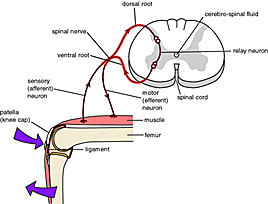(→Types) |
|||
| Line 21: | Line 21: | ||
{{Main|Sensory fiber types}} |
{{Main|Sensory fiber types}} |
||
There are several types of sensory nerve fibers, depending on their modality etc. Examples are: |
There are several types of sensory nerve fibers, depending on their modality etc. Examples are: |
||
| + | *[[General somatic afferent fibers|GSA]], |
||
| − | *Ia & II |
||
| + | *[[General visceral afferent fibers|GVA]], |
||
| − | *Ib |
||
| + | *[[Special somatic afferent|SSA]], |
||
| − | *Aβ |
||
| + | *[[Special visceral afferent|SVA]], |
||
| − | *Aδ |
||
| + | *[[Fiber types|fibers]] ([[Type Ia sensory fiber|Ia]], [[Golgi tendon organ|Ib or Golgi]], [[Type II sensory fiber|II or Aβ]], [[A delta fiber|III or Aδ or fast pain]], [[C fiber|IV or C or slow pain]]) |
||
| − | *C |
||
==See also== |
==See also== |
||
Latest revision as of 11:08, 26 November 2011
Assessment |
Biopsychology |
Comparative |
Cognitive |
Developmental |
Language |
Individual differences |
Personality |
Philosophy |
Social |
Methods |
Statistics |
Clinical |
Educational |
Industrial |
Professional items |
World psychology |
Biological: Behavioural genetics · Evolutionary psychology · Neuroanatomy · Neurochemistry · Neuroendocrinology · Neuroscience · Psychoneuroimmunology · Physiological Psychology · Psychopharmacology (Index, Outline)

The mechanism of the reflex arc
Sensory neurons (or afferent neurons or receptor neurons) are nerve cells within the nervous system responsible for converting external stimuli from the organism's environment into internal electrical motor reflex loops and several forms of involuntary behavior, including pain avoidance. In humans, such reflex circuits are commonly located in the spinal cord.
The sensory neurons carry signals from a wide range of receptors which include:
- Baroreceptors
- Chemoreceptors
- Mechanoreceptors
- Nociceptors
- Photoreceptors
- Proprioceptors
- Taste buds
- Thermoreceptors
At the molecular level, these sensory receptors located on the cell membrane of sensory neurons are responsible for the conversion of stimuli into electrical impulses. The type of receptor employed by a given sensory neuron determines the type of stimuli it will be sensitive to. For example, neurons containing mechanoreceptors are sensitive to tactile stimuli, while olfactory receptors make a cell sensitive to odors.
In complex organisms, sensory neurons then relay their information to the central nervous system or in less complex organisms, such as the hydra, directly to motor neurons and sensory neurons also transmit information to the brain, where it can be further processed and acted upon. For example, olfactory sensory neurons make synapses with neurons of the olfactory bulb, where the sense of olfaction (smell) is processed. This information can be used by organisms to make decisions on whether to eat a particular piece of food, or whether a potential partner is ready to mate.
Types
- Main article: Sensory fiber types
There are several types of sensory nerve fibers, depending on their modality etc. Examples are:
- GSA,
- GVA,
- SSA,
- SVA,
- fibers (Ia, Ib or Golgi, II or Aβ, III or Aδ or fast pain, IV or C or slow pain)
See also
- Afferent nerve
- Afferent pathways
- Auditory neurons
- Receptive fields
- Taste disorders
- Type Ia sensory fiber
- Nerve
- Pseudounipolar neuron
References & Bibliography
Key texts
Books
Papers
Additional material
Books
Papers
External links
| This page uses Creative Commons Licensed content from Wikipedia (view authors). |